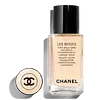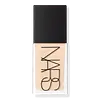Chanel Les Beiges Healthy Glow Foundation Versus NARS Cosmetics Light Reflecting Advanced Skincare Foundation
What's inside
What's inside
 Key Ingredients
Key Ingredients

 Benefits
Benefits

 Concerns
Concerns

 Ingredients Side-by-side
Ingredients Side-by-side

Water
Skin ConditioningDicaprylyl Carbonate
EmollientDimethicone
EmollientGlycerin
HumectantLauryl PEG-9 Polydimethylsiloxyethyl Dimethicone
Skin ConditioningSynthetic Fluorphlogopite
Isononyl Isononanoate
EmollientPentylene Glycol
Skin ConditioningPolymethylsilsesquioxane
Limnanthes Alba Seed Oil
Skin ConditioningTrimethylsiloxysilicate
EmollientKalanchoe Pinnata Leaf Extract
MaskingDimethicone/Vinyl Dimethicone Crosspolymer
Skin ConditioningStearalkonium Hectorite
Gel FormingParfum
MaskingDimethicone Crosspolymer
Emulsion StabilisingMagnesium Sulfate
Chlorphenesin
AntimicrobialCaprylyl Glycol
EmollientPropylene Carbonate
SolventAluminum Hydroxide
EmollientSodium Lauroyl Glutamate
Triethoxycaprylylsilane
Lysine
Skin ConditioningIsoceteth-10
EmulsifyingSilica
AbrasiveAlumina
AbrasiveMagnesium Chloride
Maltodextrin
AbsorbentTocopherol
AntioxidantCI 77491
Cosmetic ColorantCI 77492
Cosmetic ColorantCI 77499
Cosmetic ColorantCI 77891
Cosmetic ColorantWater, Dicaprylyl Carbonate, Dimethicone, Glycerin, Lauryl PEG-9 Polydimethylsiloxyethyl Dimethicone, Synthetic Fluorphlogopite, Isononyl Isononanoate, Pentylene Glycol, Polymethylsilsesquioxane, Limnanthes Alba Seed Oil, Trimethylsiloxysilicate, Kalanchoe Pinnata Leaf Extract, Dimethicone/Vinyl Dimethicone Crosspolymer, Stearalkonium Hectorite, Parfum, Dimethicone Crosspolymer, Magnesium Sulfate, Chlorphenesin, Caprylyl Glycol, Propylene Carbonate, Aluminum Hydroxide, Sodium Lauroyl Glutamate, Triethoxycaprylylsilane, Lysine, Isoceteth-10, Silica, Alumina, Magnesium Chloride, Maltodextrin, Tocopherol, CI 77491, CI 77492, CI 77499, CI 77891
Water
Skin ConditioningC9-12 Alkane
SolventButylene Glycol
HumectantUndecane
EmollientTridecane
PerfumingIsodecyl Neopentanoate
EmollientHydrogenated Polyisobutene
EmollientPolyglyceryl-6 Polyricinoleate
EmulsifyingPolyglyceryl-2 Diisostearate
EmulsifyingDisteardimonium Hectorite
StabilisingDiisostearyl Malate
EmollientGlycerin
HumectantSynthetic Wax
AbrasiveSodium Chloride
MaskingOphiopogon Japonicus Root Extract
Skin ConditioningAscophyllum Nodosum Extract
Skin ConditioningTheobroma Cacao Seed Extract
AntioxidantCurcuma Longa Root Extract
MaskingSilybum Marianum Fruit Extract
Skin ConditioningAluminum Hydroxide
EmollientMagnesium Chloride
Sodium Dilauramidoglutamide Lysine
HumectantTocopherol
AntioxidantCoco-Caprylate/Caprate
EmollientEthylhexylglycerin
Skin ConditioningPentylene Glycol
Skin ConditioningHydroxyphenyl Propamidobenzoic Acid
Skin ConditioningAscorbyl Palmitate
AntioxidantCitric Acid
BufferingSea Water
HumectantTrisodium EDTA
CI 77120
Cosmetic ColorantAlumina
AbrasiveChlorphenesin
AntimicrobialPhenoxyethanol
PreservativePotassium Sorbate
PreservativeIron Oxides
Mica
Cosmetic ColorantCI 77891
Cosmetic ColorantWater, C9-12 Alkane, Butylene Glycol, Undecane, Tridecane, Isodecyl Neopentanoate, Hydrogenated Polyisobutene, Polyglyceryl-6 Polyricinoleate, Polyglyceryl-2 Diisostearate, Disteardimonium Hectorite, Diisostearyl Malate, Glycerin, Synthetic Wax, Sodium Chloride, Ophiopogon Japonicus Root Extract, Ascophyllum Nodosum Extract, Theobroma Cacao Seed Extract, Curcuma Longa Root Extract, Silybum Marianum Fruit Extract, Aluminum Hydroxide, Magnesium Chloride, Sodium Dilauramidoglutamide Lysine, Tocopherol, Coco-Caprylate/Caprate, Ethylhexylglycerin, Pentylene Glycol, Hydroxyphenyl Propamidobenzoic Acid, Ascorbyl Palmitate, Citric Acid, Sea Water, Trisodium EDTA, CI 77120, Alumina, Chlorphenesin, Phenoxyethanol, Potassium Sorbate, Iron Oxides, Mica, CI 77891
 Reviews
Reviews

Ingredients Explained
These ingredients are found in both products.
Ingredients higher up in an ingredient list are typically present in a larger amount.
Alumina is another name for the compound aluminum oxide. It is used as a thickener, absorbent, and abrasive.
As an absorbent, alumina can give a mattifying effect. It is used in mineral sunscreens to help coat nano-sized filters, such as titanium dioxide. By increasing the size of the UV filters, these ingredients stay on the skin for a longer time. By coating small sized ingredients, alumina helps thicken a product.
Alumina may be used as an abrasive, or exfoliant.
Alumina is naturally occurring in the mineral corundum. Certain varieties of corundum create rubies and sapphires. Corundum is also the crystalline form of alumina.
Learn more about AluminaAluminum Hydroxide is a form of aluminum. It can be naturally found in nature as the mineral gibbsite. In cosmetics, Aluminum Hydroxide is used as a colorant, pH adjuster, and absorbent.
As a colorant, Aluminum Hydroxide may add opacity, or reduce the transparency. Aluminum hydroxide is contains both basic and acidic properties.
According to manufacturers, this ingredient is an emollient and humectant. This means it helps hydrate the skin.
In medicine, this ingredient is used to help relieve heartburn and help heal ulcers.
There is currently no credible scientific evidence linking aluminum hydroxide in cosmetics to increased cancer risk.
Major health organizations allow the use of aluminum hydroxide in personal care products and have not flagged it as a carcinogenic risk at typical usage levels.
Learn more about Aluminum HydroxideChlorphenesin is a synthetic preservative. It helps protect a product against bacteria in order to extend shelf life. In most cases, Chlorphenesin is paired with other preservatives such as phenoxyethanol and caprylyl glycol.
Chlorphenesin is a biocide. This means it is able to help fight the microorganisms on our skin. It is also able to fight odor-releasing bacteria.
Chlorphenesin is soluble in both water and glycerin.
Studies show Chlorphenesin is easily absorbed by our skin. You should speak with a skincare professional if you have concerns about using Chlorphenesin.
Learn more about ChlorphenesinCi 77891 is a white pigment from Titanium dioxide. It is naturally found in minerals such as rutile and ilmenite.
It's main function is to add a white color to cosmetics. It can also be mixed with other colors to create different shades.
Ci 77891 is commonly found in sunscreens due to its ability to block UV rays.
Learn more about CI 77891Glycerin is already naturally found in your skin. It helps moisturize and protect your skin.
A study from 2016 found glycerin to be more effective as a humectant than AHAs and hyaluronic acid.
As a humectant, it helps the skin stay hydrated by pulling moisture to your skin. The low molecular weight of glycerin allows it to pull moisture into the deeper layers of your skin.
Hydrated skin improves your skin barrier; Your skin barrier helps protect against irritants and bacteria.
Glycerin has also been found to have antimicrobial and antiviral properties. Due to these properties, glycerin is often used in wound and burn treatments.
In cosmetics, glycerin is usually derived from plants such as soybean or palm. However, it can also be sourced from animals, such as tallow or animal fat.
This ingredient is organic, colorless, odorless, and non-toxic.
Glycerin is the name for this ingredient in American English. British English uses Glycerol/Glycerine.
Learn more about GlycerinWe don't have a description for Magnesium Chloride yet.
Pentylene glycol is typically used within a product to thicken it. It also adds a smooth, soft, and moisturizing feel to the product. It is naturally found in plants such as sugar beets.
The hydrophilic trait of Pentylene Glycol makes it a humectant. As a humectant, Pentylene Glycol helps draw moisture from the air to your skin. This can help keep your skin hydrated.
This property also makes Pentylene Glycol a great texture enhancer. It can also help thicken or stabilize a product.
Pentylene Glycol also acts as a mild preservative and helps to keep a product microbe-free.
Some people may experience mild eye and skin irritation from Pentylene Glycol. We always recommend speaking with a professional about using this ingredient in your routine.
Pentylene Glycol has a low molecular weight and is part of the 1,2-glycol family.
Learn more about Pentylene GlycolTocopherol (also known as Vitamin E) is a common antioxidant used to help protect the skin from free-radicals and strengthen the skin barrier. It's also fat soluble - this means our skin is great at absorbing it.
Vitamin E also helps keep your natural skin lipids healthy. Your lipid skin barrier naturally consists of lipids, ceramides, and fatty acids. Vitamin E offers extra protection for your skin’s lipid barrier, keeping your skin healthy and nourished.
Another benefit is a bit of UV protection. Vitamin E helps reduce the damage caused by UVB rays. (It should not replace your sunscreen). Combining it with Vitamin C can decrease sunburned cells and hyperpigmentation after UV exposure.
You might have noticed Vitamin E + C often paired together. This is because it is great at stabilizing Vitamin C. Using the two together helps increase the effectiveness of both ingredients.
There are often claims that Vitamin E can reduce/prevent scarring, but these claims haven't been confirmed by scientific research.
Learn more about TocopherolWater. It's the most common cosmetic ingredient of all. You'll usually see it at the top of ingredient lists, meaning that it makes up the largest part of the product.
So why is it so popular? Water most often acts as a solvent - this means that it helps dissolve other ingredients into the formulation.
You'll also recognize water as that liquid we all need to stay alive. If you see this, drink a glass of water. Stay hydrated!
Learn more about Water